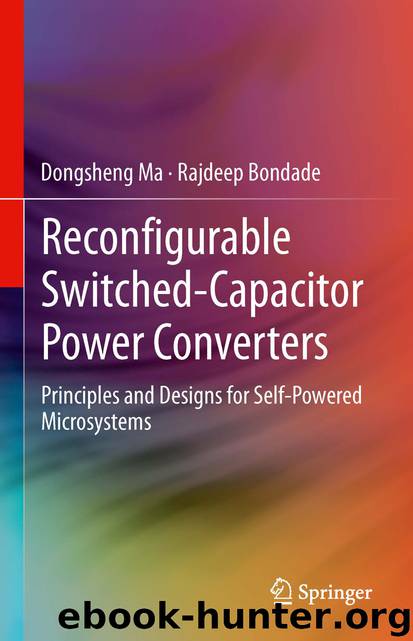Reconfigurable Switched-Capacitor Power Converters by Dongsheng Ma & Rajdeep Bondade

Author:Dongsheng Ma & Rajdeep Bondade
Language: eng
Format: epub
Publisher: Springer New York, New York, NY
5.2.1 SFG Modeling and Design Approach
SFG techniques have been applied to switch mode power converter designs to analyze and evaluate both large-signal and small-signal characteristics as well as stability conditions. In this section, a SFG is developed for SC power converters. The SFG modeling is implemented under the following assumptions: (1) all power switches are assumed to be ideal; (2) passive components (pumping and output filtering capacitors) are assumed to be linear and time-invariant; (3) equivalent series resistance (ESR) of capacitors is neglected.
The first step of the SFG modeling is to define every node in the graph. In general, from the discussion on charge pump topologies in Sect. 5.1, it is known that in order to achieve 2N + 1 CGs in a SC power converter, N pumping capacitors C P1, C P2, …, C PN are needed. Thus, there will be 2N + 4 nodes in the SFG, which are the input voltage and current (V in and I in) nodes, output voltage and current (V out and I out nodes, where I out = current flowing into the output filtering capacitor + load current), voltage across and current flowing through each pumping capacitor (V CPi and I CPi (i = 1, 2… N)). For example, if we choose N = 2 to achieve 5 CGs, the SFG then includes 8 nodes.
In order to model this charge pump using a SFG, the first step is to create the correct connections between the nodes. These connections in general represent different charge/discharge paths in the SC power converter, which will provide the different CGs. For example, of the 5 CGs that can be delivered by the charge pump, let us consider the capacitor configurations for which CG = 3/2. To regulate V out appropriately, the two pumping capacitors C P1 and C P2 have to be connected in series between V in and ground during the charge phase Φ1 = 1, as illustrated in Fig. 5.10. During the discharge phase Φ2 = 1, the pumping capacitors are connected in parallel between V in and V out. Using the SFG approach, it is now possible to construct a power stage employing the fewest number of power devices.
Fig. 5.10Pumping capacitor configurations to obtain CG = 3/2
Download
This site does not store any files on its server. We only index and link to content provided by other sites. Please contact the content providers to delete copyright contents if any and email us, we'll remove relevant links or contents immediately.
| Circuits | Digital Design |
| Electric Machinery & Motors | Electronics |
| Fiber Optics | Networks |
| Superconductivity |
Whiskies Galore by Ian Buxton(41884)
Introduction to Aircraft Design (Cambridge Aerospace Series) by John P. Fielding(33064)
Small Unmanned Fixed-wing Aircraft Design by Andrew J. Keane Andras Sobester James P. Scanlan & András Sóbester & James P. Scanlan(32744)
Craft Beer for the Homebrewer by Michael Agnew(18145)
Turbulence by E. J. Noyes(7942)
The Complete Stick Figure Physics Tutorials by Allen Sarah(7310)
Kaplan MCAT General Chemistry Review by Kaplan(6868)
The Thirst by Nesbo Jo(6832)
Bad Blood by John Carreyrou(6555)
Modelling of Convective Heat and Mass Transfer in Rotating Flows by Igor V. Shevchuk(6391)
Learning SQL by Alan Beaulieu(6212)
Weapons of Math Destruction by Cathy O'Neil(6148)
Man-made Catastrophes and Risk Information Concealment by Dmitry Chernov & Didier Sornette(5924)
Digital Minimalism by Cal Newport;(5667)
Life 3.0: Being Human in the Age of Artificial Intelligence by Tegmark Max(5476)
iGen by Jean M. Twenge(5367)
Secrets of Antigravity Propulsion: Tesla, UFOs, and Classified Aerospace Technology by Ph.D. Paul A. Laviolette(5310)
Design of Trajectory Optimization Approach for Space Maneuver Vehicle Skip Entry Problems by Runqi Chai & Al Savvaris & Antonios Tsourdos & Senchun Chai(5011)
Pale Blue Dot by Carl Sagan(4913)
